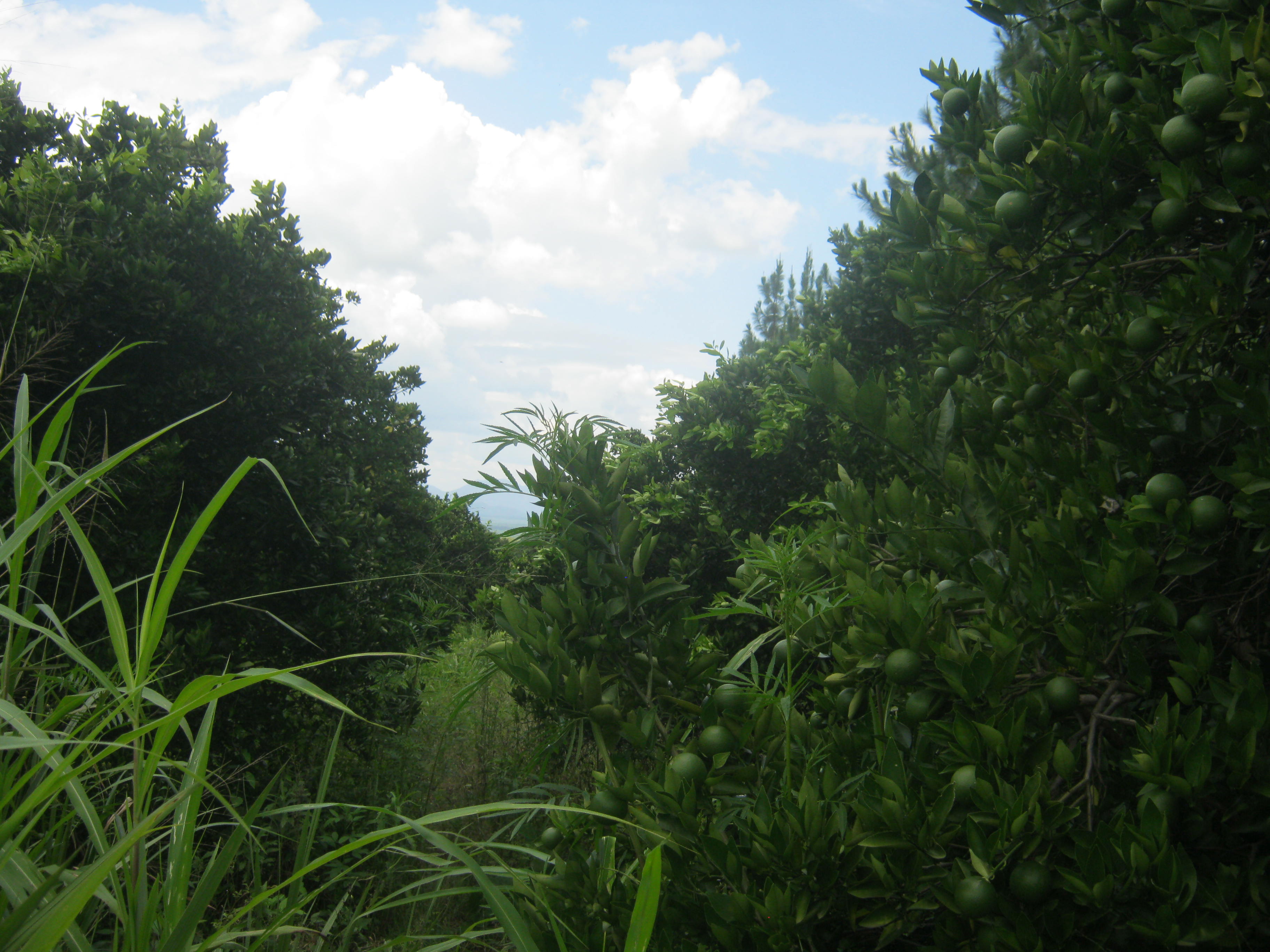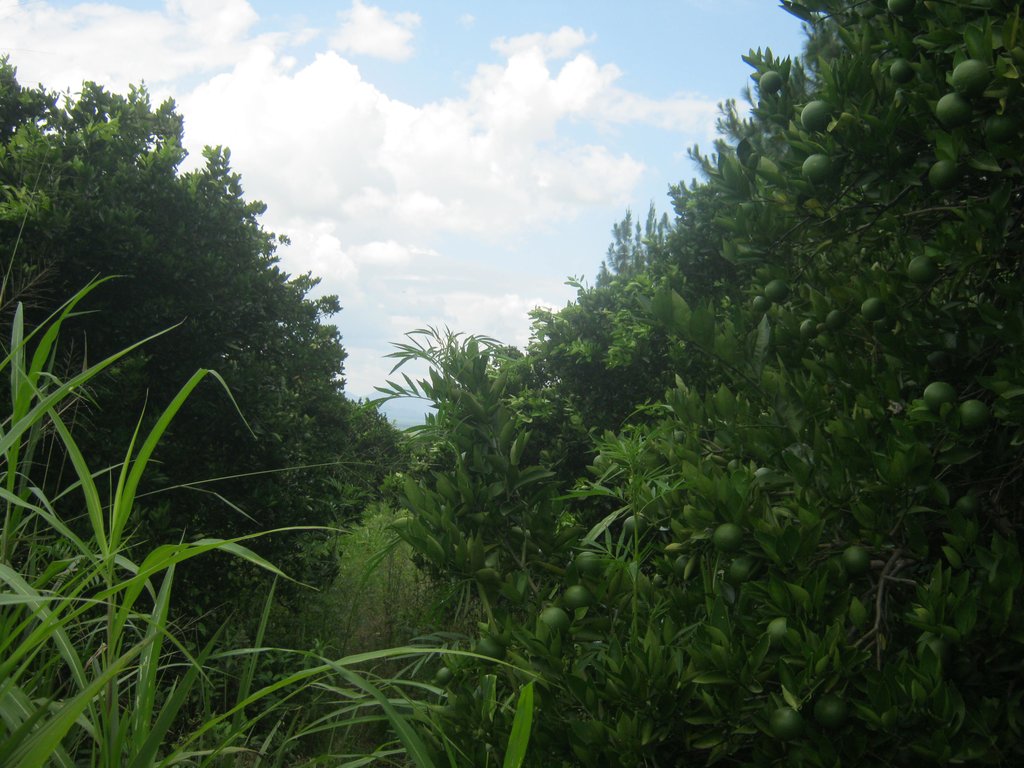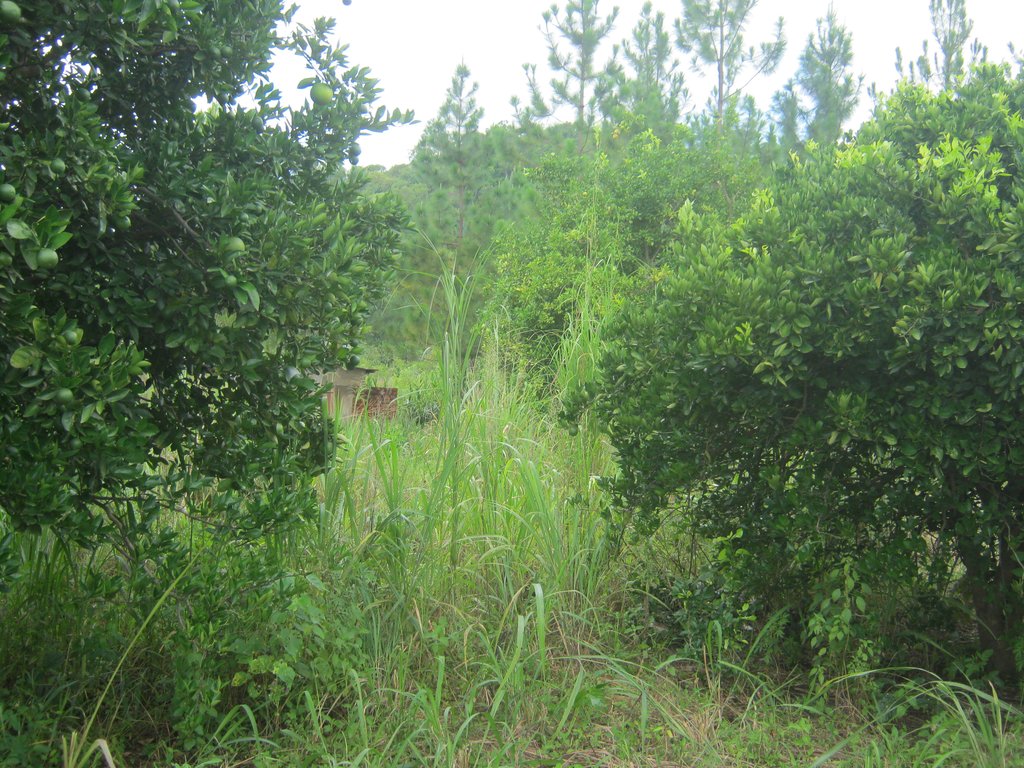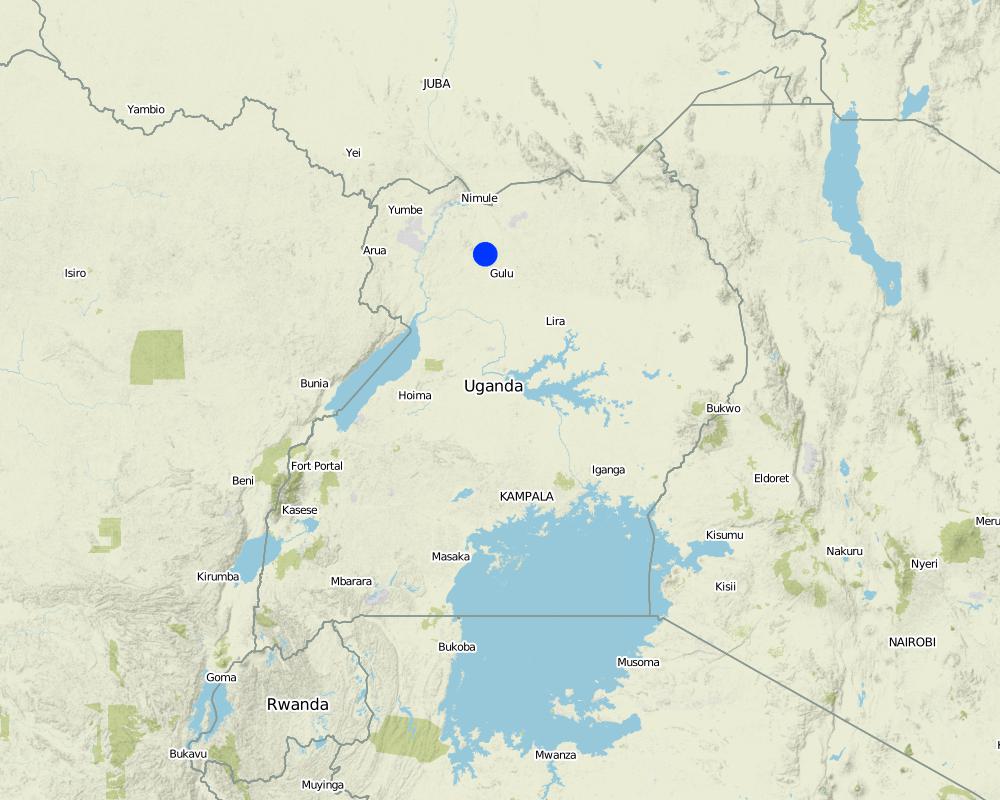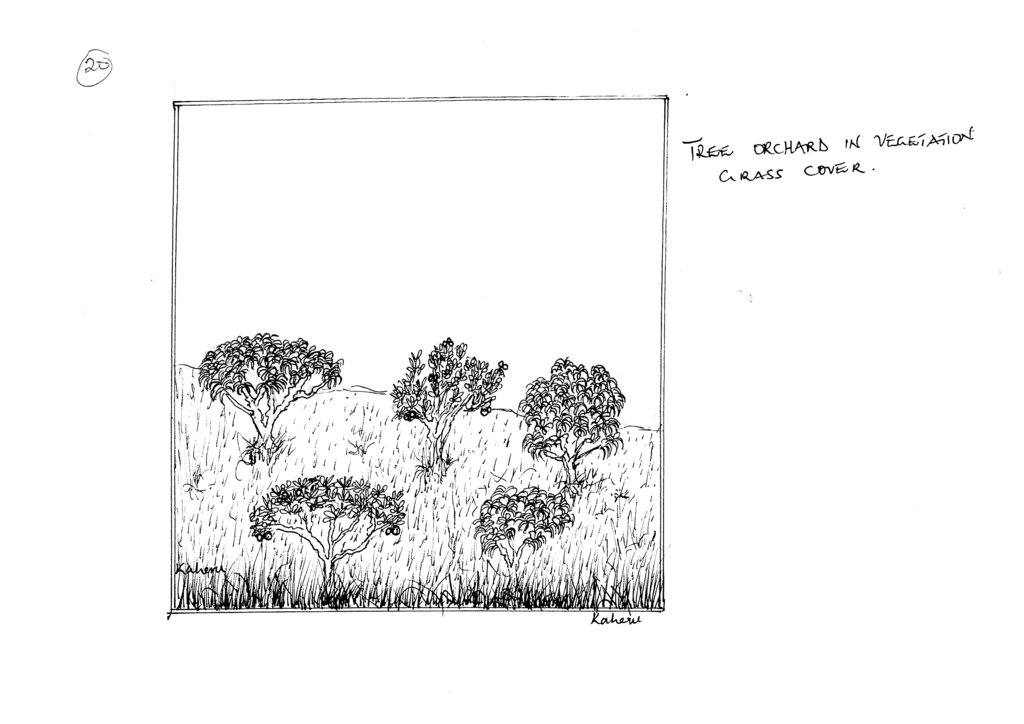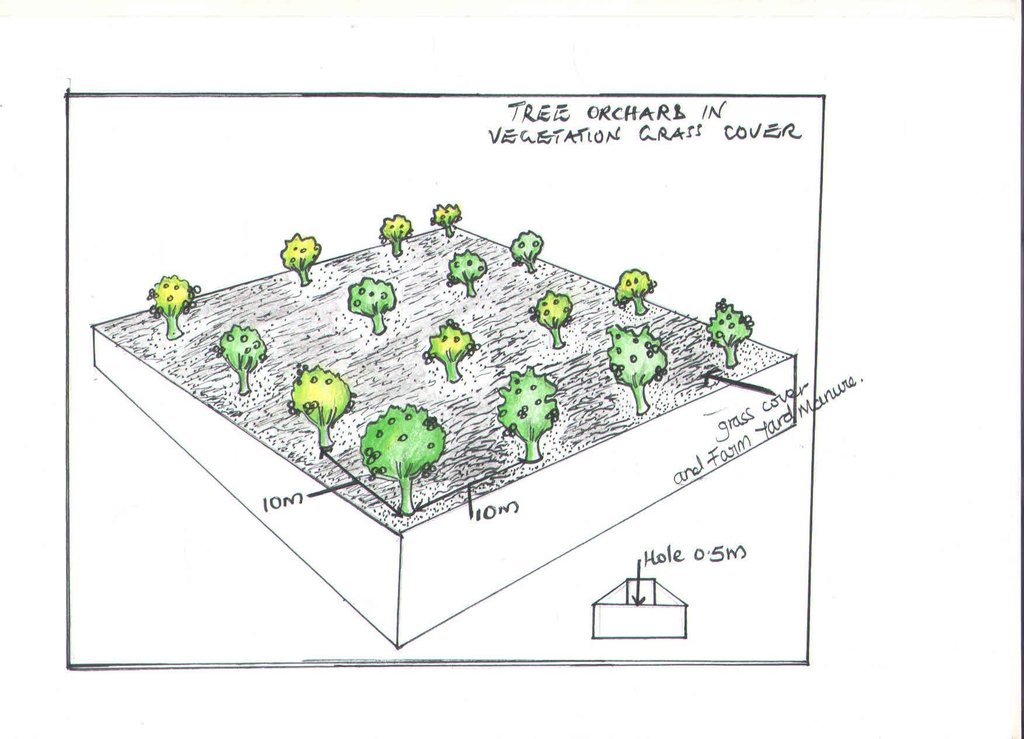Orchard of mangoes and oranges for food and income security [乌干达]
- 创建:
- 更新:
- 编制者: Kamugisha Rick Nelson
- 编辑者: JOY TUKAHIRWA, Richard Otto Kawawa, Sunday Balla Amale, Bernard Fungo
- 审查者: Donia Mühlematter, John Stephen Tenywa, Nicole Harari, Renate Fleiner
Poto Muyema akuba
technologies_2819 - 乌干达
查看章节
全部展开 全部收起1. 一般信息
1.2 参与该技术评估和文件编制的资源人员和机构的联系方式
关键资源人
土地使用者:
Akello Scovia
Amuru District Farmers froup
乌干达
有助于对技术进行记录/评估的项目名称(如相关)
Scaling-up SLM practices by smallholder farmers (IFAD)有助于对技术进行记录/评估的机构名称(如相关)
CDE Centre for Development and Environment (CDE Centre for Development and Environment) - 瑞士1.3 关于使用通过WOCAT记录的数据的条件
编制者和关键资源人员接受有关使用通过WOCAT记录数据的条件。:
是
1.4 所述技术的可持续性声明
这里所描述的技术在土地退化方面是否存在问题,导致无法被认为是一种可持续的土地管理技术?:
否
2. SLM技术的说明
2.1 技术简介
技术定义:
Species of Mangoes and Oranges planted for income and food security.
2.2 技术的详细说明
说明:
Growing mangoes and oranges is becoming a common practice among farmers in Northern Uganda for food security and increased household income. As seasons become shorter and erratic, failure of traditional crops like beans and maize is increasing. Mangoes and oranges are more adapted to sub-humid conditions and can endure longer dry spells yet yield well. Thus, farmers are taking on improved varieties of mangoes and oranges developed by the National Agricultural Research System. The mango and orange seedlings are planted with only spot weeding to maintain the grass cover for soil moisture. The activities involved in establishing the orchards include (1) linking up with the extension worker for information on what varieties and how to plant on which type of soils (2) site selection (3) buying seedlings (4) planting and (4) watering if planted during the dry season with the following input requirements seedlings, hired labour of at least 2-3 people paid on monthly basis and watering can. At the time of planting the land user digs a hole up to a depth of about 0.5 metres using a fork so that the roots are allowed to grow out easily and plant the fruit trees spaced at 10 metres x 10 metres allowing the grass to grow without removing or cutting. If planting is done in the dry season and the ground is too dry the farmer applies water once a week slowly using a bucket so that it has time to sink in the soil. If the land user plants during the wet season, watering is not necessary. This practice is liked because yields are high due to leaves litter as well as the demand for fruits in addition to being easily fertilised using organic fertilizer locally obtained and treated . In the long run, the high costs incurred at the time of establishment in buying seedlings and paying labour. The presence of fruits from the orchard provides both food and income to the household, which should be other crops such as maize and sim fail due to drought. What is not liked about this technology is that the grass grown in the garden is liked by livestock during the dry season. Herdsmen searching for pasture drive their animals into the gardens, resulting into constant conflicts between livestock owners and the land user. The grass also poses a risk of fire during the dry season. Additional efforts to put in place a community bylaw on controlled grazing would reduce conflicts and free range grazing of animals contrarily to fencing which may be an additional benefit to sustainably managing land by the land user.
2.3 技术照片
2.4 技术视频
注释、简短说明:
Video Showing tree Orchard for soil fertility improvement.
日期:
26/05/2017
位置:
Pakuma viallge , Palong parish, Pabbo sub-county Amuru District
摄影师的名字:
Issa Aiga
2.5 已应用该技术的、本评估所涵盖的国家/地区/地点
国家:
乌干达
区域/州/省:
Amuru District, Northern Region,Uganda
具体说明该技术的分布:
- 均匀地分布在一个区域
如果不知道精确的区域,请注明大致覆盖的区域:
- < 0.1 平方千米(10 公顷)
注释:
Map showing technology site in Northern Uganda.
Map
×2.6 实施日期
注明实施年份:
2012
如果不知道确切的年份,请说明大概的日期:
- 不到10年前(最近)
2.7 技术介绍
详细说明该技术是如何引入的:
- 通过土地使用者的创新
- 通过项目/外部干预
注释(项目类型等):
Supported by Norther Uganda Social Action Fund.
3. SLM技术的分类
3.1 该技术的主要目的
- 改良生产
- 减少、预防、恢复土地退化
- 创造有益的经济影响
3.4 供水
该技术所应用土地的供水:
- 雨养
3.5 该技术所属的SLM组
- 农业林学
- 改良的地面/植被覆盖
3.6 包含该技术的可持续土地管理措施

农艺措施
- A1:植被和土壤覆盖层
- A2:有机质/土壤肥力
- A3:土壤表面处理
- A4:地表下处理
- A5:种子管理,改良品种

植物措施
- V1:乔木和灌木覆盖层

管理措施
- M5:物种组成的控制/变化
3.7 该技术强调的主要土地退化类型

土壤水蚀
- Wt:表土流失/地表侵蚀
- Wg:冲沟侵蚀/沟蚀

土壤风蚀
- Et:表土流失

化学性土壤退化
- Cn:肥力下降和有机质含量下降(非侵蚀所致)

物理性土壤退化
3.8 防止、减少或恢复土地退化
具体数量名该技术与土地退化有关的目标:
- 防止土地退化
- 修复/恢复严重退化的土地
4. 技术规范、实施活动、投入和成本
4.1 该技术的技术图纸
4.2 有关投入和成本计算的一般信息
具体说明成本和投入是如何计算的:
- 每个技术区域
注明尺寸和面积单位:
0.5 acres
其它/国家货币(具体说明):
UGX
如相关,注明美元与当地货币的汇率(例如1美元=79.9巴西雷亚尔):1美元=:
3400.0
注明雇用劳工的每日平均工资成本:
5000 per person per day but in most cases charge more than this depending on the season (sunny or rainy season)- sunny more money is charged.
4.3 技术建立活动
| 活动 | 时间(季度) | |
|---|---|---|
| 1. | Look for land | Before estaslishment |
| 2. | Look for seedlings and tools to use | Once before establishment |
| 3. | Look for labour | Before establishment |
| 4. | Dig holes (2-3 ft) | During establishment |
| 5. | Plant suckers | During establishment |
| 6. | Water: dry season | After estabslishment |
| 7. | Weeding | After estabslishment |
4.4 技术建立所需要的费用和投入
| 对投入进行具体说明 | 单位 | 数量 | 单位成本 | 每项投入的总成本 | 土地使用者承担的成本% | |
|---|---|---|---|---|---|---|
| 劳动力 | Labour | persons | 3.0 | 5000.0 | 15000.0 | 100.0 |
| 设备 | Hoe | Pieces | 1.0 | 10000.0 | 10000.0 | 100.0 |
| 设备 | Spray pump hire for a week | Pieces | 1.0 | 35000.0 | 35000.0 | 100.0 |
| 设备 | Panga | Pieces | 2.0 | 7000.0 | 14000.0 | 100.0 |
| 植物材料 | Seedlings | Kgs | 42.0 | 2500.0 | 105000.0 | 100.0 |
| 肥料和杀菌剂 | Pestcide | Litres | 0.5 | 15000.0 | 7500.0 | |
| 肥料和杀菌剂 | Fertilizer | 2.0 | 1.0 | 2.0 | ||
| 肥料和杀菌剂 | Organic fertilizer (weekly) | bags | 2.0 | 30000.0 | 60000.0 | |
| 技术建立所需总成本 | 246502.0 | |||||
4.5 维护/经常性活动
| 活动 | 时间/频率 | |
|---|---|---|
| 1. | Slashing | Around December every year |
| 2. | Spraying with herbicide against pests | Every time they are observed |
| 3. | Weeding | Twice a year |
| 4. | Watering | During the dry season, when they are young |
| 5. | Fertilisation | Twice a year |
4.6 维护/经常性活动所需要的费用和投入(每年)
| 对投入进行具体说明 | 单位 | 数量 | 单位成本 | 每项投入的总成本 | 土地使用者承担的成本% | |
|---|---|---|---|---|---|---|
| 劳动力 | Labour for on daily basis | Persons | 3.0 | 5000.0 | 15000.0 | 100.0 |
| 设备 | Hire of spray pump for one week | Pieces | 7.0 | 5000.0 | 35000.0 | 100.0 |
| 技术维护所需总成本 | 50000.0 | |||||
4.7 影响成本的最重要因素
描述影响成本的最决定性因素:
Labour takes the most of costs.
5. 自然和人文环境
5.1 气候
年降雨量
- < 250毫米
- 251-500毫米
- 501-750毫米
- 751-1,000毫米
- 1,001-1,500毫米
- 1,501-2,000毫米
- 2,001-3,000毫米
- 3,001-4,000毫米
- > 4,000毫米
指定年平均降雨量(若已知),单位为mm:
1500.00
有关降雨的规范/注释:
March April at the on set of the forst rainy season and second rainy season on set in the month of August.
农业气候带
- 半湿润
5.2 地形
平均坡度:
- 水平(0-2%)
- 缓降(3-5%)
- 平缓(6-10%)
- 滚坡(11-15%)
- 崎岖(16-30%)
- 陡峭(31-60%)
- 非常陡峭(>60%)
地形:
- 高原/平原
- 山脊
- 山坡
- 山地斜坡
- 麓坡
- 谷底
垂直分布带:
- 0-100 m a.s.l.
- 101-500 m a.s.l.
- 501-1,000 m a.s.l.
- 1,001-1,500 m a.s.l.
- 1,501-2,000 m a.s.l.
- 2,001-2,500 m a.s.l.
- 2,501-3,000 m a.s.l.
- 3,001-4,000 m a.s.l.
- > 4,000 m a.s.l.
说明该技术是否专门应用于:
- 凹陷情况
5.3 土壤
平均土层深度:
- 非常浅(0-20厘米)
- 浅(21-50厘米)
- 中等深度(51-80厘米)
- 深(81-120厘米)
- 非常深(> 120厘米)
土壤质地(表土):
- 中粒(壤土、粉土)
土壤质地(地表以下> 20厘米):
- 中粒(壤土、粉土)
表土有机质:
- 中(1-3%)
5.4 水资源可用性和质量
地下水位表:
< 5米
地表水的可用性:
中等
水质(未处理):
不良饮用水(需要处理)
水的盐度有问题吗?:
否
该区域正在发生洪水吗?:
否
关于水质和水量的注释和进一步规范:
The flooding occurs during the month of excess heavy rains (Nov-Dec and March-May).
5.5 生物多样性
物种多样性:
- 高
栖息地多样性:
- 中等
5.6 应用该技术的土地使用者的特征
定栖或游牧:
- 定栖的
生产系统的市场定位:
- 生计(自给)
非农收入:
- 低于全部收入的10%
相对财富水平:
- 平均水平
个人或集体:
- 个人/家庭
机械化水平:
- 手工作业
性别:
- 男人
土地使用者的年龄:
- 青年人
- 中年人
5.7 应用该技术的土地使用者使用的平均土地面积
- < 0.5 公顷
- 0.5-1 公顷
- 1-2 公顷
- 2-5公顷
- 5-15公顷
- 15-50公顷
- 50-100公顷
- 100-500公顷
- 500-1,000公顷
- 1,000-10,000公顷
- > 10,000公顷
这被认为是小规模、中规模还是大规模的(参照当地实际情况)?:
- 小规模的
5.8 土地所有权、土地使用权和水使用权
土地所有权:
- 社区/村庄
土地使用权:
- 社区(有组织)
用水权:
- 社区(有组织)
5.9 进入服务和基础设施的通道
健康:
- 贫瘠
- 适度的
- 好
教育:
- 贫瘠
- 适度的
- 好
技术援助:
- 贫瘠
- 适度的
- 好
就业(例如非农):
- 贫瘠
- 适度的
- 好
市场:
- 贫瘠
- 适度的
- 好
能源:
- 贫瘠
- 适度的
- 好
道路和交通:
- 贫瘠
- 适度的
- 好
饮用水和卫生设施:
- 贫瘠
- 适度的
- 好
金融服务:
- 贫瘠
- 适度的
- 好
- 贫瘠
- 适度的
- 好
6. 影响和结论性说明
6.1 该技术的现场影响
社会经济效应
生产
作物生产
注释/具体说明:
Due to leaves litter.
作物质量
注释/具体说明:
due to grass cover and maintaining soil fertility.
产品多样性
注释/具体说明:
Mangoes and oranges.
收入和成本
农业投入费用
注释/具体说明:
Only paying for for labour to do simple weeding.
农业收入
注释/具体说明:
From sale of fruits.
社会文化影响
食品安全/自给自足
注释/具体说明:
Fruits - oranges and mangoes.
Selling mangoes and oranges and buying food.
国家机构
注释/具体说明:
Operation Wealth Creation (OWC) / National Agricultural Advisory Services (NAADS).
SLM/土地退化知识
注释/具体说明:
Use of grass cover and littered leaves.
冲突缓解
注释/具体说明:
Conflicts caused by roaming animals searching for pasture.
生态影响
水循环/径流
地表径流
注释/具体说明:
Due to grass cover.
土壤
土壤水分
注释/具体说明:
Due to grass cover.
土壤覆盖层
注释/具体说明:
Due to grass cover and leaves.
土壤流失
土壤有机物/地下C
注释/具体说明:
Due to mulching.
生物多样性:植被、动物
植被覆盖
注释/具体说明:
Due to permanent grass cover.
植物多样性
注释/具体说明:
Due to allowed growth of the vegetation cover.
有益物种
减少气候和灾害风险
滑坡/泥石流
6.2 该技术的场外影响已经显现
水资源可用性
注释/具体说明:
Due to presence of vegetation cover.
6.3 技术对渐变气候以及与气候相关的极端情况/灾害的暴露和敏感性(土地使用者认为的极端情况/灾害)
渐变气候
渐变气候
| 季节 | 增加或减少 | 该技术是如何应对的? | |
|---|---|---|---|
| 年温度 | 减少 | 好 | |
| 季节性温度 | 湿季/雨季 | 减少 | 好 |
| 年降雨量 | 增加 | 适度 | |
| 季雨量 | 湿季/雨季 | 增加 | 好 |
气候有关的极端情况(灾害)
气候灾害
| 该技术是如何应对的? | |
|---|---|
| 干旱 | 好 |
| 陆地火灾 | 非常好 |
生物灾害
| 该技术是如何应对的? | |
|---|---|
| 昆虫/蠕虫侵扰 | 好 |
6.4 成本效益分析
技术收益与技术建立成本相比如何(从土地使用者的角度看)?
短期回报:
稍微积极
长期回报:
非常积极
技术收益与技术维护成本/经常性成本相比如何(从土地使用者的角度看)?
短期回报:
稍微积极
长期回报:
积极
6.5 技术采用
- > 50%
在所有采用这项技术的人当中,有多少人是自发的,即未获得任何物质奖励/付款?:
- 51-90%
6.6 适应
最近是否对该技术进行了修改以适应不断变化的条件?:
否
6.7 该技术的优点/长处/机会
| 土地使用者眼中的长处/优势/机会 |
|---|
| Appropriate for small and large scale land users. |
| The technology can be replicated elsewhere by other farmers. |
| 编制者或其他关键资源人员认为的长处/优势/机会 |
|---|
| Good at providing income when mangoes and oranges are sold. |
| Appreciated by the land user due its ability to provide household income and fruits for consumption and sale. |
6.8 技术的弱点/缺点/风险及其克服方法
| 土地使用者认为的弱点/缺点/风险 | 如何克服它们? |
|---|---|
| Requires skilled labour at the time of establishment to dig the holes and applying the right spacing. |
Train family labour to acquire the skills. Use extension workers and expert farmers to provide the skills |
| The technology is liked by thieves since it provides income and food. |
Fencing to prevent intruders from piking the fruits without payment. Put in place strict byelws and harsh penalties for offenders. |
| 编制者或其他关键资源人员认为的弱点/缺点/风险 | 如何克服它们? |
|---|---|
| Fruit trees are having canopies in close contact hence reduced fruiting with the spreading of branches. The technology is not well managed as would be expected. | The farmer should trim the branches. |
7. 参考和链接
7.1 信息的方法/来源
- 实地考察、实地调查
01
- 与土地使用者的访谈
01
(现场)数据是什么时候汇编的?:
26/05/2017
链接和模块
全部展开 全部收起链接
无链接
模块
无模块


